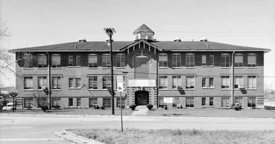Thomas School: Difference between revisions
No edit summary |
No edit summary |
||
| Line 1: | Line 1: | ||
[[Image:Thomas School.jpg|right|thumb|275px|The Thomas School in March, 1995]] | [[Image:Thomas School.jpg|right|thumb|275px|The Thomas School in March, 1995]] | ||
The '''Thomas School''' was an early school, built for black children, in the [[Birmingham Public School System]]. | The '''Thomas School''' was an early school, built for black children, in the [[Birmingham Public School System]]. | ||
==1st Thomas School== | |||
The first Thomas School, serving 1,000 black students in East Birmingham, burned in the mid-1890s. Although the Board of Education collected an insurance claim for the loss of the building, it made no plans to replace the school, instead renting space in the basement of a church. Frequent flooding caused classes to be dismissed for days at a time. After continued urging by the Black community and by Mayor [[George Ward]] who had overseen a $300,000 bond issue for school improvements, plans for a new Thomas School were prepared. | |||
==2nd Thomas School== | |||
The new brick building, located at 3420 [[2nd Avenue North]] in [[North Avondale]], was designed by African-American architect [[Wallace Rayfield]]. It was constructed in [[1910]] and was considered exceptional among schools for African Americans for its quality of design and equipment. A [[1912]] report in ''The Survey'' related that the teachers and students took "much pride in keeping it free from marks of use.'' | |||
==Disuse== | |||
For a while after it no longer served students, the building was used as a special services counseling center for the [[Birmingham Board of Education|Board of Education]]. It was eventually abandoned and fell into disrepair with parts of the roof collapsing. | |||
==Jimmie Hale Mission== | |||
In 2002 the [[Birmingham City Council]] unanimously passed a resolution to approve a forty year lease of the Thomas School property to the [[Jimmie Hale Mission]], which proposed to stabilize and refurbish the property as its new home. At the end of the the $1/year lease, the mission would have the option to purchase the property from the city for $100. (Ordinance No. 02-131). The mission broke ground on the improvements in 2005 and expects to move in summer 2006. | In 2002 the [[Birmingham City Council]] unanimously passed a resolution to approve a forty year lease of the Thomas School property to the [[Jimmie Hale Mission]], which proposed to stabilize and refurbish the property as its new home. At the end of the the $1/year lease, the mission would have the option to purchase the property from the city for $100. (Ordinance No. 02-131). The mission broke ground on the improvements in 2005 and expects to move in summer 2006. | ||
==References== | ==References== | ||
* McKelway, A. J. (January 6, 1912) "Conservation of Childhood." ''The Survey'' Special issue "[http://bplonline.cdmhost.com/u?/p4017coll8,677 Birmingham: Smelting Iron Ore and Civics]." Vol. 27, No. 14, pp. 1515-26 - accessed from the Birmingham Public Library's digital collections April 12, 2007 | * McKelway, A. J. (January 6, 1912) "Conservation of Childhood." ''The Survey'' Special issue "[http://bplonline.cdmhost.com/u?/p4017coll8,677 Birmingham: Smelting Iron Ore and Civics]." Vol. 27, No. 14, pp. 1515-26 - accessed from the Birmingham Public Library's digital collections April 12, 2007 | ||
* LaMonte, Edward S. (1974) ''George B. Ward: Birmingham's Urban Statesman.'' Birmingham: Birmingham Public Library/Oxmoor Press | |||
[[Category:Former schools]] | [[Category:Former schools]] | ||
[[Category:Birmingham schools]] | |||
[[Category:1910 buildings]] | [[Category:1910 buildings]] | ||
[[Category:2nd Avenue North | [[Category:2nd Avenue North]] | ||
[[Category:Wallace Rayfield buildings]] | [[Category:Wallace Rayfield buildings]] | ||
Revision as of 22:50, 23 January 2008
The Thomas School was an early school, built for black children, in the Birmingham Public School System.
1st Thomas School
The first Thomas School, serving 1,000 black students in East Birmingham, burned in the mid-1890s. Although the Board of Education collected an insurance claim for the loss of the building, it made no plans to replace the school, instead renting space in the basement of a church. Frequent flooding caused classes to be dismissed for days at a time. After continued urging by the Black community and by Mayor George Ward who had overseen a $300,000 bond issue for school improvements, plans for a new Thomas School were prepared.
2nd Thomas School
The new brick building, located at 3420 2nd Avenue North in North Avondale, was designed by African-American architect Wallace Rayfield. It was constructed in 1910 and was considered exceptional among schools for African Americans for its quality of design and equipment. A 1912 report in The Survey related that the teachers and students took "much pride in keeping it free from marks of use.
Disuse
For a while after it no longer served students, the building was used as a special services counseling center for the Board of Education. It was eventually abandoned and fell into disrepair with parts of the roof collapsing.
Jimmie Hale Mission
In 2002 the Birmingham City Council unanimously passed a resolution to approve a forty year lease of the Thomas School property to the Jimmie Hale Mission, which proposed to stabilize and refurbish the property as its new home. At the end of the the $1/year lease, the mission would have the option to purchase the property from the city for $100. (Ordinance No. 02-131). The mission broke ground on the improvements in 2005 and expects to move in summer 2006.
References
- McKelway, A. J. (January 6, 1912) "Conservation of Childhood." The Survey Special issue "Birmingham: Smelting Iron Ore and Civics." Vol. 27, No. 14, pp. 1515-26 - accessed from the Birmingham Public Library's digital collections April 12, 2007
- LaMonte, Edward S. (1974) George B. Ward: Birmingham's Urban Statesman. Birmingham: Birmingham Public Library/Oxmoor Press
